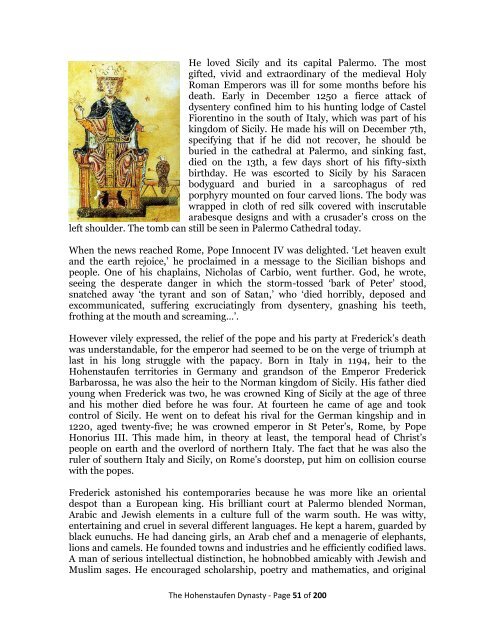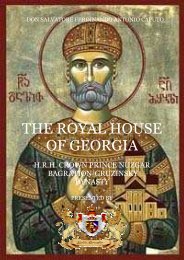here - Nobility Associations
here - Nobility Associations
here - Nobility Associations
Create successful ePaper yourself
Turn your PDF publications into a flip-book with our unique Google optimized e-Paper software.
He loved Sicily and its capital Palermo. The most<br />
gifted, vivid and extraordinary of the medieval Holy<br />
Roman Emperors was ill for some months before his<br />
death. Early in December 1250 a fierce attack of<br />
dysentery confined him to his hunting lodge of Castel<br />
Fiorentino in the south of Italy, which was part of his<br />
kingdom of Sicily. He made his will on December 7th,<br />
specifying that if he did not recover, he should be<br />
buried in the cathedral at Palermo, and sinking fast,<br />
died on the 13th, a few days short of his fifty-sixth<br />
birthday. He was escorted to Sicily by his Saracen<br />
bodyguard and buried in a sarcophagus of red<br />
porphyry mounted on four carved lions. The body was<br />
wrapped in cloth of red silk covered with inscrutable<br />
arabesque designs and with a crusader’s cross on the<br />
left shoulder. The tomb can still be seen in Palermo Cathedral today.<br />
When the news reached Rome, Pope Innocent IV was delighted. ‘Let heaven exult<br />
and the earth rejoice,’ he proclaimed in a message to the Sicilian bishops and<br />
people. One of his chaplains, Nicholas of Carbio, went further. God, he wrote,<br />
seeing the desperate danger in which the storm-tossed ‘bark of Peter’ stood,<br />
snatched away ‘the tyrant and son of Satan,’ who ‘died horribly, deposed and<br />
excommunicated, suffering excruciatingly from dysentery, gnashing his teeth,<br />
frothing at the mouth and screaming…’.<br />
However vilely expressed, the relief of the pope and his party at Frederick’s death<br />
was understandable, for the emperor had seemed to be on the verge of triumph at<br />
last in his long struggle with the papacy. Born in Italy in 1194, heir to the<br />
Hohenstaufen territories in Germany and grandson of the Emperor Frederick<br />
Barbarossa, he was also the heir to the Norman kingdom of Sicily. His father died<br />
young when Frederick was two, he was crowned King of Sicily at the age of three<br />
and his mother died before he was four. At fourteen he came of age and took<br />
control of Sicily. He went on to defeat his rival for the German kingship and in<br />
1220, aged twenty-five; he was crowned emperor in St Peter’s, Rome, by Pope<br />
Honorius III. This made him, in theory at least, the temporal head of Christ’s<br />
people on earth and the overlord of northern Italy. The fact that he was also the<br />
ruler of southern Italy and Sicily, on Rome’s doorstep, put him on collision course<br />
with the popes.<br />
Frederick astonished his contemporaries because he was more like an oriental<br />
despot than a European king. His brilliant court at Palermo blended Norman,<br />
Arabic and Jewish elements in a culture full of the warm south. He was witty,<br />
entertaining and cruel in several different languages. He kept a harem, guarded by<br />
black eunuchs. He had dancing girls, an Arab chef and a menagerie of elephants,<br />
lions and camels. He founded towns and industries and he efficiently codified laws.<br />
A man of serious intellectual distinction, he hobnobbed amicably with Jewish and<br />
Muslim sages. He encouraged scholarship, poetry and mathematics, and original<br />
The Hohenstaufen Dynasty - Page 51 of 200



